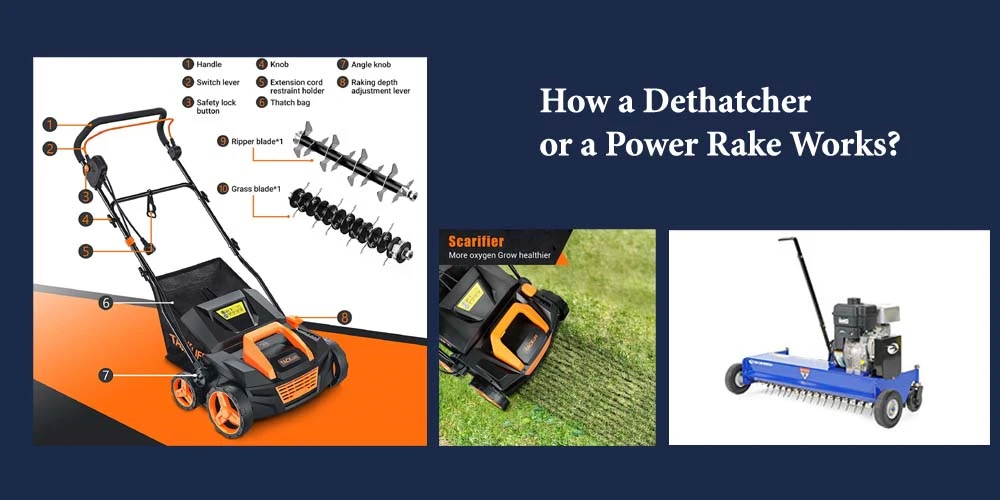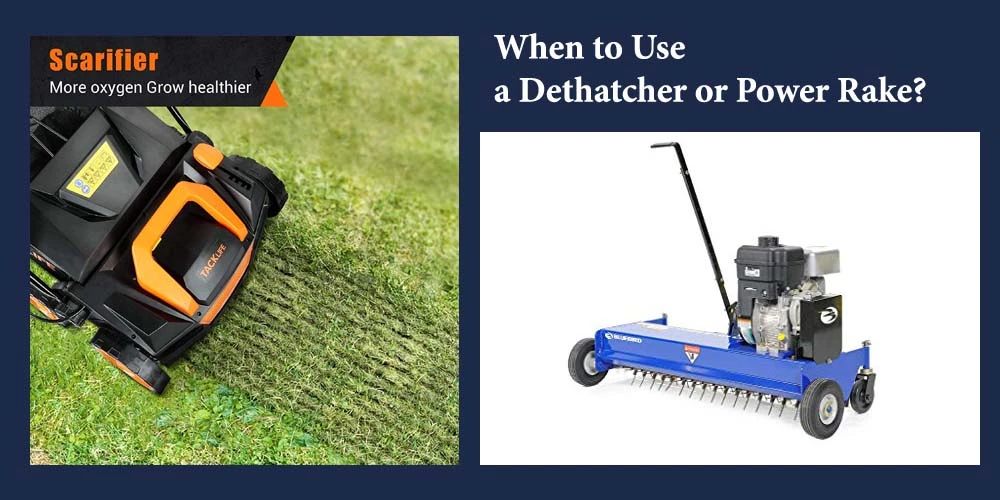reviewed by Christina Lopez
If you want to ensure that the seed you put down germinates appropriately, you need to loosen up the thatch (excess grass material that goes dormant or cut grass clippings that build up over time) before seeding. You may think to use a power rake or a dethatcher for your lawn, depending on the condition of your grass. Read in this article on Power Rake VS Dethatchers.
So what is the distinction between a power rake or a dethatcher, and how do they function?
To scrape thatch from the grass, use a power rake or a dethatcher. A power rake is even more aggressive in removing dead grass debris. Spring tines are used by lawn dethatchers, while spinning flails are used by control rakes. Both devices are fully automated and can operate on either gas or electricity.
Contents

Dethatching, or power raking, scraping thatch, or a sheet of dead grass and dirt from the lawn. Usually, this barrier prevents fertilizer from entering the soil. It also inhibits air movement and sunlight exposure.
A dethatching unit, also known as a dethatcher, is used to scrap grass thatch. It may be manual or gas-powered. Dethatcher effectively dethatches your grass, mainly if it is small and only has a thin layer of thatch on top of the soil. But it is not ideal for vast lawns and applicable without destroying the grass. A pull-behind is often helpful for small yards, but it can be a workout.
On the other hand, a power rake scours the debris covering the grass with flails that spin at a reasonable speed. Power raking is an excellent method for removing over thatch and overseeding. The machine loosens and picks up the debris, leaving the soil’s surface even more vulnerable than before. Improper lawn mowing and watering methods can cause your lawn to develop a layer of dead grass gradually. Soon enough, you’ll see a brown color growing under the grass leaves on your lawn. When you mow the lawn, this brown coating of dead turf, clippings, and stolons becomes more visible with time.
A power rake is similar to a dethatcher in that they both scrape thatch and debris. But they do so in separate ways—Dethatching or power raking, both address the same issue in the lawn, thatch, and litter.
All you can do is-

Here, I have brought some common things together (Power Rake VS Dethatchers) for better understanding.
| Dethatcher | Power Rakers |
| Dethatching is less aggressive. | Power Rakers is more aggressive. |
| Dethatcher removes tiny amounts of thatch from a lawn. | Power Rakers removes large amounts of thatch from a lawn. |
| Dethatchers are smaller, residential-grade machines. | Power Rakers are the big, commercial-grade machine. |
| Dethatchers are applicable for small areas of grass or turf, like a push mower, or may attach to a mower or tiller. | Electric rakes work for large areas of grass or turf, heavy-duty, and consume more power. |
| Dethatchers use steel spring tines to penetrate less than half an inch and remove a small amount of thatch. | Power rakes have steel flails tines can penetrate more than 4x as much thatch and remove a small amount of thatch. |
| Dethatchers are usually sold for personal use. | Power rakes are usually sold business-to-business. |
| Dethatchers are simple, easy to use, and have no chance to destroy your lawn. | Power Raking could destroy your lawn if you don’t know how to operate |
| Limited skill is enough to work perfectly. | Need the skill to operate perfectly |
| Dethatchers need less energy to use in your lawn. | Dethatchers need more energy to use in your lawn |
| Need small room to store. | May need a large room to store |
Note: (Power Rake VS Dethatchers)
Power raking and dethatching are also used to get rid of excess thatch in the grass. A power rake helps remove the dense layer of debris accumulated on top of the soil. On the other hand, a dethatcher helps scrape a thin layer of decomposing organic matter.
Power raking is a more vigorous method of extracting thatch and dead matter from the grass. While dethatching is a gentle method of removing a thin layer of debris that prevents fertilizer absorption.
A dethatcher is a machine rake with spinning flails that spin to dislodge the layer of thatch. The flails pull up dense coats of thatch from the grass with vigor.
Dethatcher resembles a push lawnmower in appearance. Any of them are available as lawn mower attachments. On the other hand, a control rake is a large-scale system that extracts large volumes of thatch from a lawn. Power rakes are capable of removing up to four times the amount of thatch that a dethatcher would.

Dethatching is a valuable tool and can be effective in early spring or late autumn. It’s a good idea to do this before beginning your spring fertilizer and maintenance routine. All you should is –
Best Way to Use a Dethatcher or Power Rake
You are always in confusion about applying a dethatcher or a power rake. Now you understand the differences between a dethatcher and a power rake (Power Rake VS Dethatchers). First and foremost, if you find dead thatch in your lawn stopping it from breathing and healthy grass from thriving, you can use one of the two tools.
You would need to power rake or a dethatcher to clear the old debris when you mulch or fertilize your lawn. Whether you have a thin coating of thatch on your roof, or if you want to skip thatch entirely, use a dethatcher.
If you have a heavily thatched lawn and haven’t done much dethatching in a few years, it’s probably time to dethatch. Power raking is a recommended method of addressing a severe thatch issue. But it’s important to note that it can’t be performed regularly because it will vacuum out the lawn.
 |
 |
 |
 |

About Christina Lopez
Christina Lopez grew up in the scenic city of Mountain View, California. For eighteen ascetic years, she refrained from eating meat until she discovered the exquisite delicacy of chicken thighs. Christina is a city finalist competitive pingpong player, an ocean diver, and an ex-pat in England and Japan. Currently, she is a computer science doctoral student. Christina writes late at night; most of her daytime is spent enchanting her magical herb garden.
 |
 |
 |
 |
Get new FREE Gifts. Or latest free growing e-books from our latest works.
Disable Ad block to reveal all the links. Once done, hit a button below
 |
 |
 |
 |